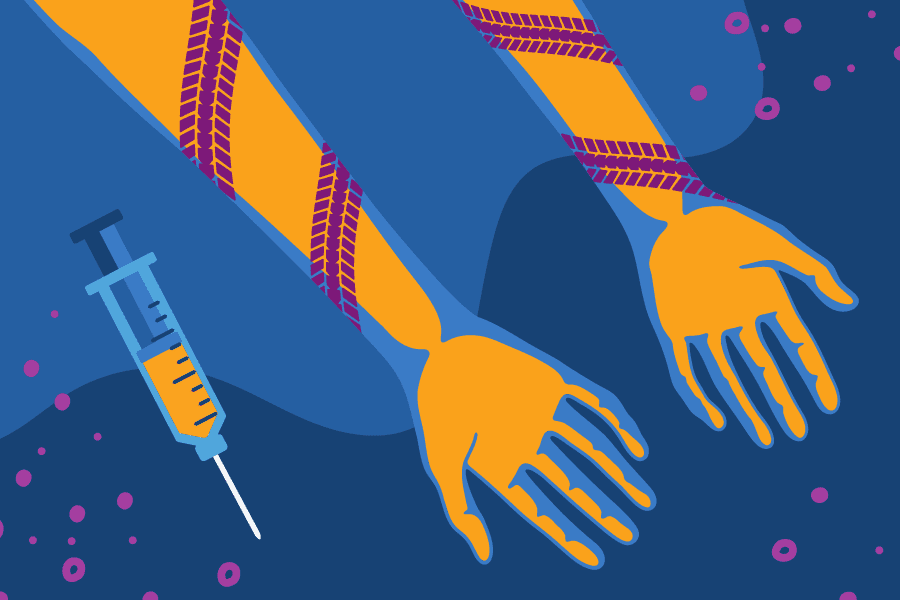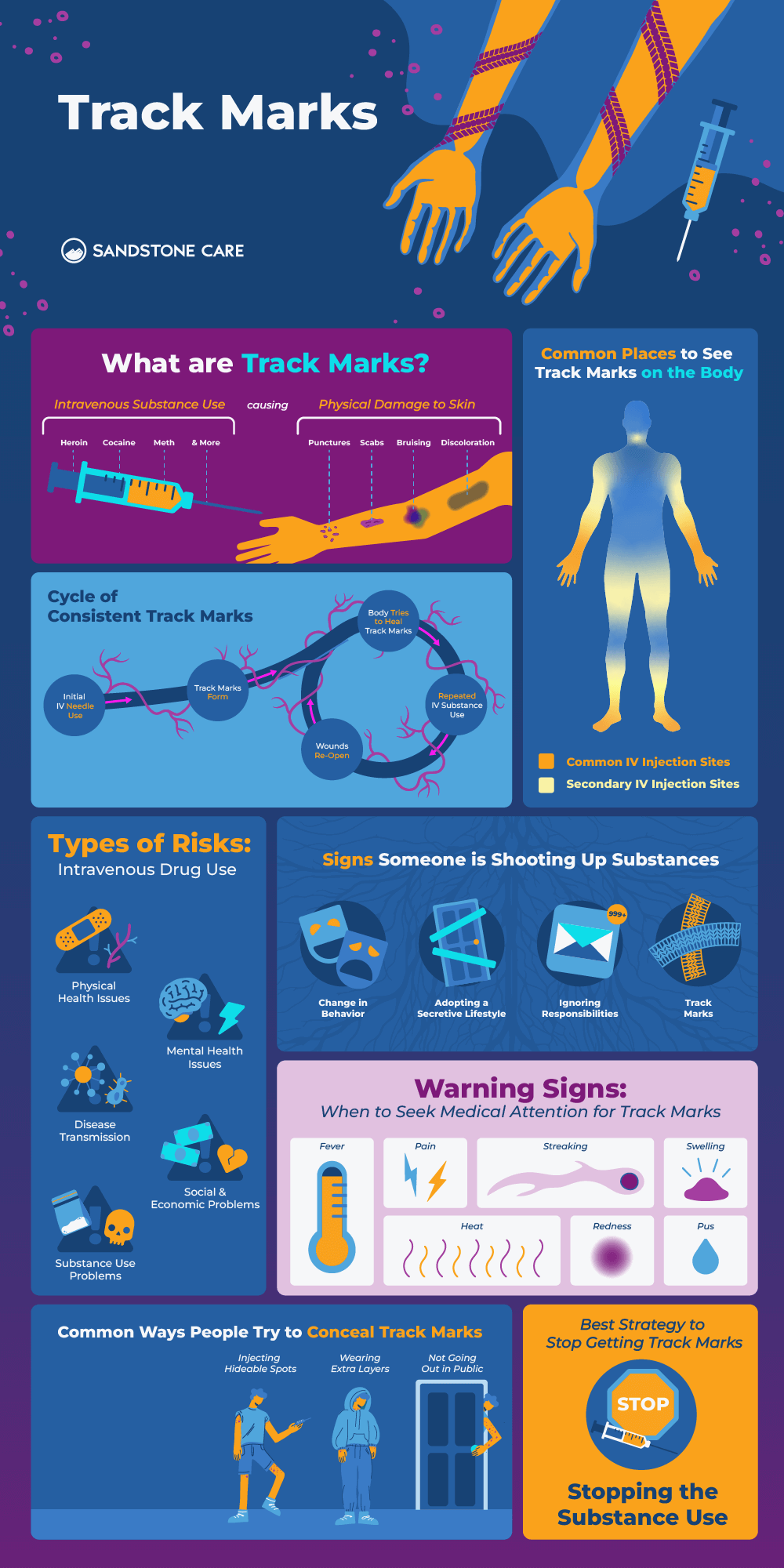What Are Track Marks?
Track marks are one of the tell-tale signs of intravenous drug use. They often manifest as small puncture wounds across various areas of the body.
They are also known as needle marks, injection marks, or puncture marks. These signs of drug use often involve small scabs, puncture wounds, and redness around the injection site of IV drugs. It can also lead to further physical health challenges, such as lesions and ulcers. Finding a treatment to address IV drug abuse once track marks are found is essential.

What Is the Medical Term for Track Marks?
Track marks may also be known as venipuncture marks.
While “track marks” is the more widely recognized term, “venipuncture marks” may also be used to describe the signs of intravenous drug use, especially when discussing the physical effects and consequences of injection drug use with medical professionals.
What Causes Track Marks?
Track marks are caused by intravenous drug use and manifest at the injection site on a person’s body.
Puncturing of the skin and veins, especially when done repeatedly, can cause bruising, collapsed veins, discoloration, scabs, and even scar tissue at the injection site.

Another method of injecting drugs, known as “skin popping,” involves injecting into the skin, rather than the veins, to try and have a slower absorption of the drug. However, this method can also lead to scar tissue.
What Do Track Marks Look Like?
Physical signs of track marks can appear as scabs, redness, discoloration, and more.
Scabs associated with track marks may also have difficulty healing, and these signs can persist for long stretches of time. For some, injecting drugs at the same site over and over again can make it difficult for track marks to heal. For others, the effects of substance abuse can compromise a person’s physical health and diet, which makes it difficult for old scars to get the nutrients they need to heal properly.
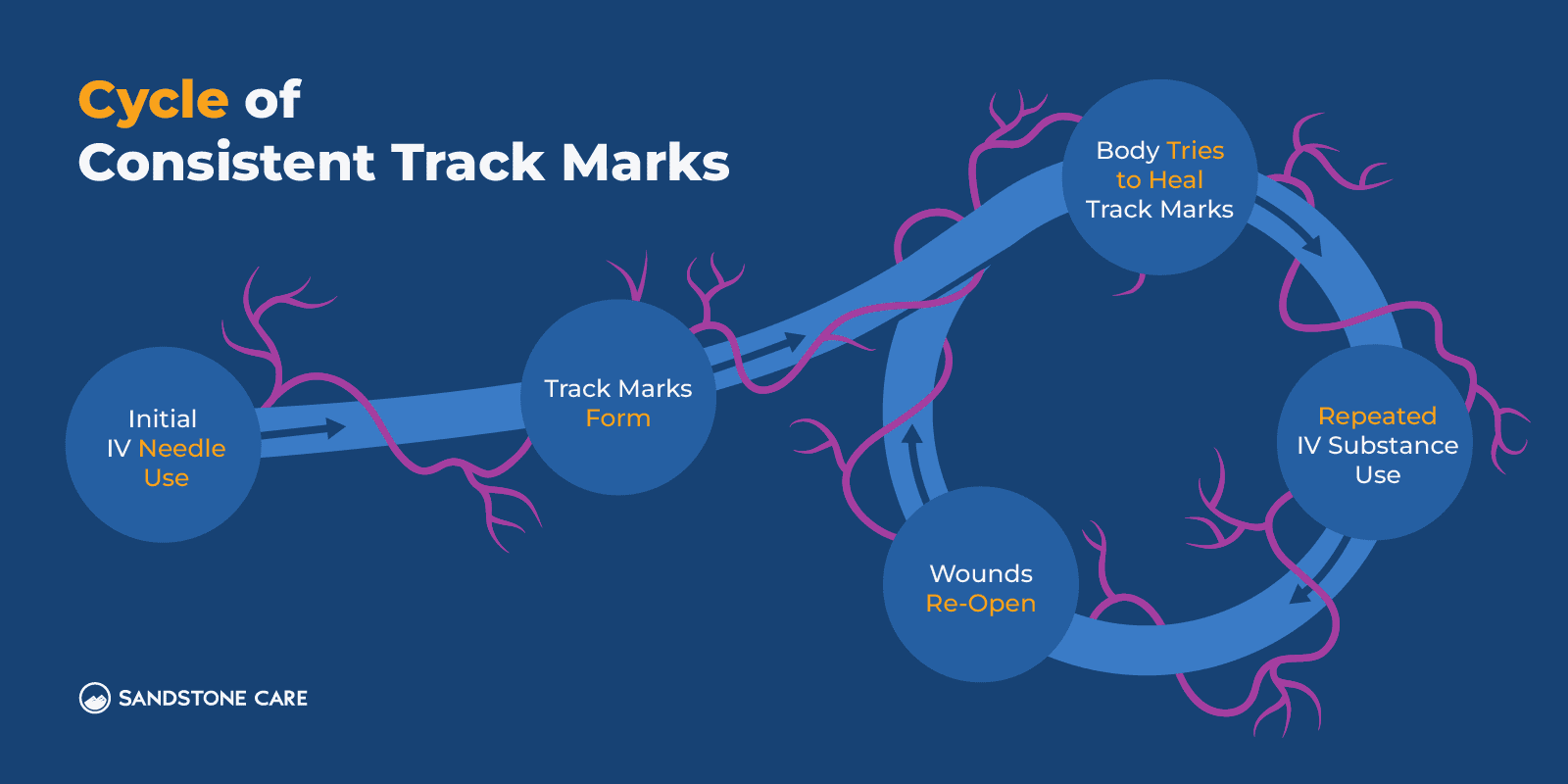
What Are the Common Risks Associated with IV Drug Use and Track Marks?
Track marks can also be signs that an individual is at an increased risk of other health risks and health problems as a result of drug abuse. Some of these risks include:
- Vein damage
- Collapsed veins
- Compromised blood flow and blood clots
- Scarring
- Ulcers
- Bruising
- Abscesses
Needles can further these challenges, especially if an individual is using old needles or sharing needles with others. Some of these risks include:
- Hepatitis B
- Hepatitis C
- Skin infections
These risks, combined with the mental health challenges of drug addiction, mean that it is crucial that those with track marks get the medical, mental, and emotional support that they need for a healthy future.
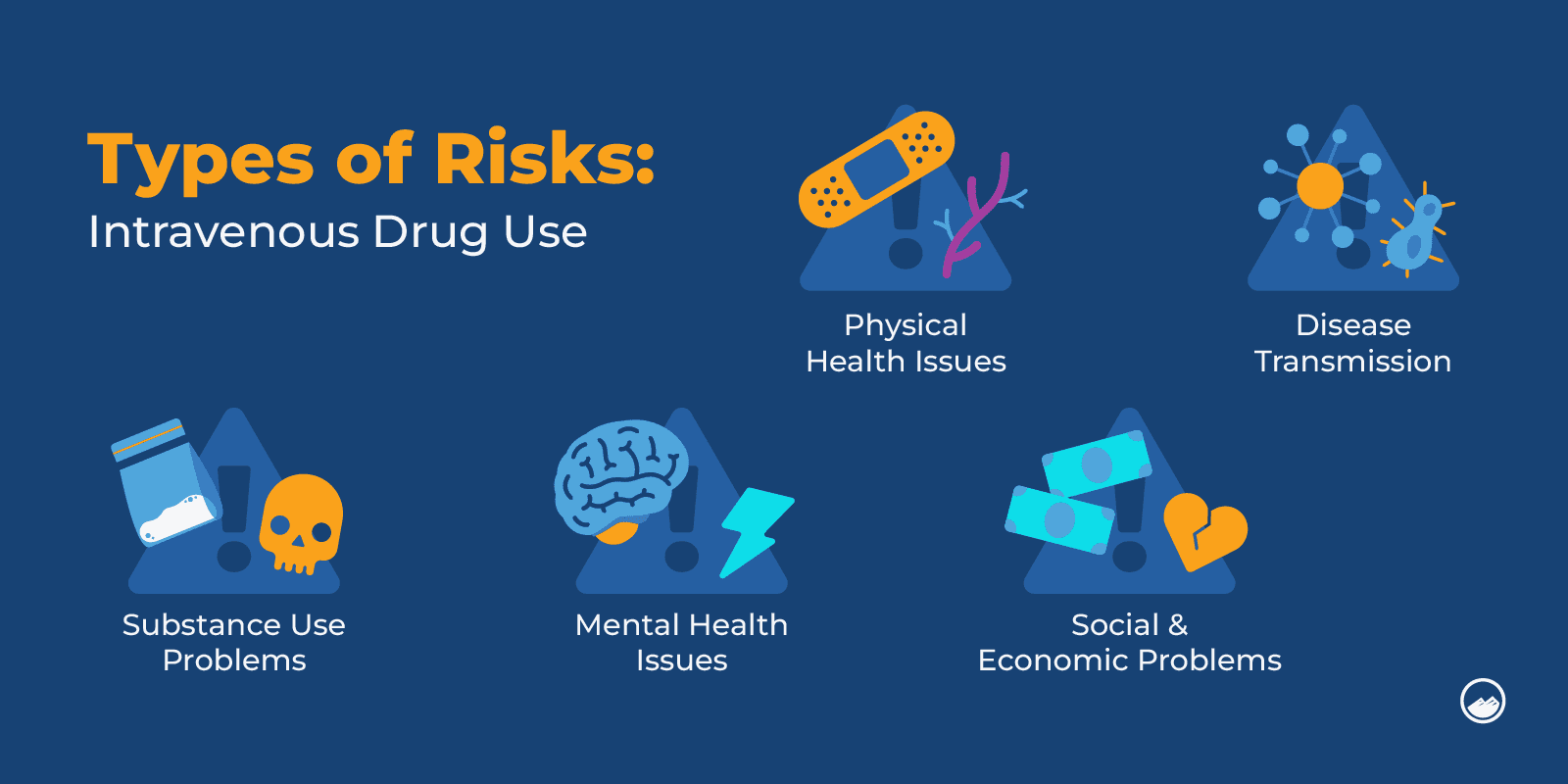
What Drugs Cause Track Marks?
Any drug that is injected directly into a person’s body can leave track marks.
The most common drugs associated with IV drug use include:
- Heroin use
- Prescribed opioids
- Prescription stimulants
- Cocaine
- Methamphetamine
- Morphine
- Fentanyl
Finding an effective treatment center to address heroin track marks, heroin addiction, opioid addiction, or any other kind of IV drug use is essential to overcoming substance abuse.
Drug Injection Sites
What Is a Drug Injection Site?
A drug injection site is anywhere where drugs are used intravenously. They can be found on different parts of the body and often include signs of drug use for IV drug users. These signs may include track marks, bruising, scabs, and other visible effects of drug use.
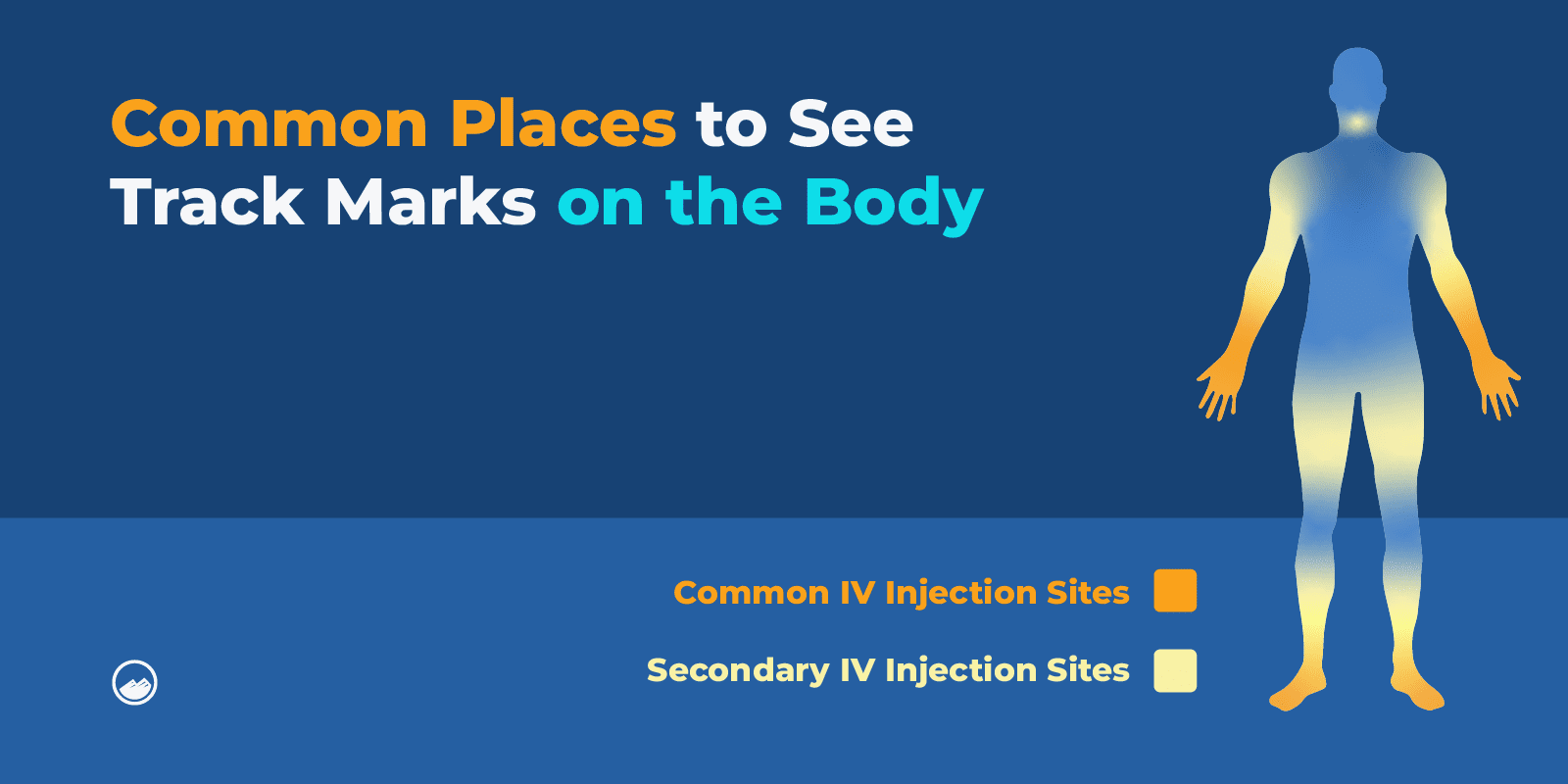
Is it Normal to Bruise After a Needle?
Bruising after an injection is common, especially when drugs are injected repeatedly For some, this is one of the tell-tale signs of IV drug use.
What Causes Bruising at Injection Sites?
Bruising at an injection site is most commonly the result of a blown vein. Blown veins occur when a needle punctures both sides of a vein, allowing blood to escape the vein beneath the skin.
How to Treat Injection Site Reactions
Reacting to the injection site is another potential side effect of IV drug use. Reactions can add even more to the physical damage that injecting drugs has on the human body.
Treating injection site reactions can be complicated, as they can be caused by many different factors. Using old needles or sharing needles with others can add to the unsanitary nature of IV drug use and can put an individual at increased risk of skin infections. Some ways to address an injection site reaction include:
- A warm compress to address bruising
- Cold compresses for swelling
- Cleaning the area
- Keep the limb mobile to promote drainage
- Elevate the injection site to promote blood flow

However, infection is always possible. Discoloration, redness, and warmness at the injection site, are signs that medical treatment may be necessary. Following up with medical professionals is the best way to identify and address injection site reactions.
How to Identify Track Marks
Track marks can be a sign of IV drug use. Being able to identify physical signs of addiction can help you and your loved ones find the appropriate treatment programs for overcoming heroin addiction, opioid addiction, or other forms of IV substance use.
How to Tell If Someone is Shooting Up
Locating track marks is one way of determining drug use in a loved one.
Noticing a change in behavior such as mood swings, adopting a more secretive lifestyle, compromised ability or willingness to tend to responsibilities or personal hygiene, or compromised workplace or academic performance can all be signs of drug use.
Another sign is the evidence of track marks, such as finding scabs on various areas of the body, scar tissue, redness, discoloration, and more.
If you have noticed signs of drug use in someone you love, it’s important to open up a dialogue about getting help. This may include searching for effective addiction treatment programs for evidence-based treatment and finding support groups nearby.

What Do Track Marks Look Like on Hands?
Track marks on hands can include redness, swelling, scabs, scars, or heavily pronounced veins as a result of repeated injections.
New scabs and scabs with difficulty healing can be further signs of IV drug use in the hands.
What Do Track Marks Look Like on Arms?
Arms are a common point of injection for many IV drug users. Track marks on arms can include scabs, redness, inflammation, and bruising. Small puncture wounds and scabs that are centralized around a certain area or that form a small, thin line on the arm can also be a sign of IV drug use.
What Do Track Marks Look Like on Legs?
The legs are another common place to inject drugs, especially since these locations can be easier to hide for many IV drug users.
Small scabs, scarring, discoloration, redness, swelling, and more are all still common at these injection sites.
How Do People Hide Track Marks?
Those who use IV drugs may use many strategies to hide their drug use. Some tactics include wearing layers, injecting in the legs or other hideable parts of the body, and using makeup to cover up scars.
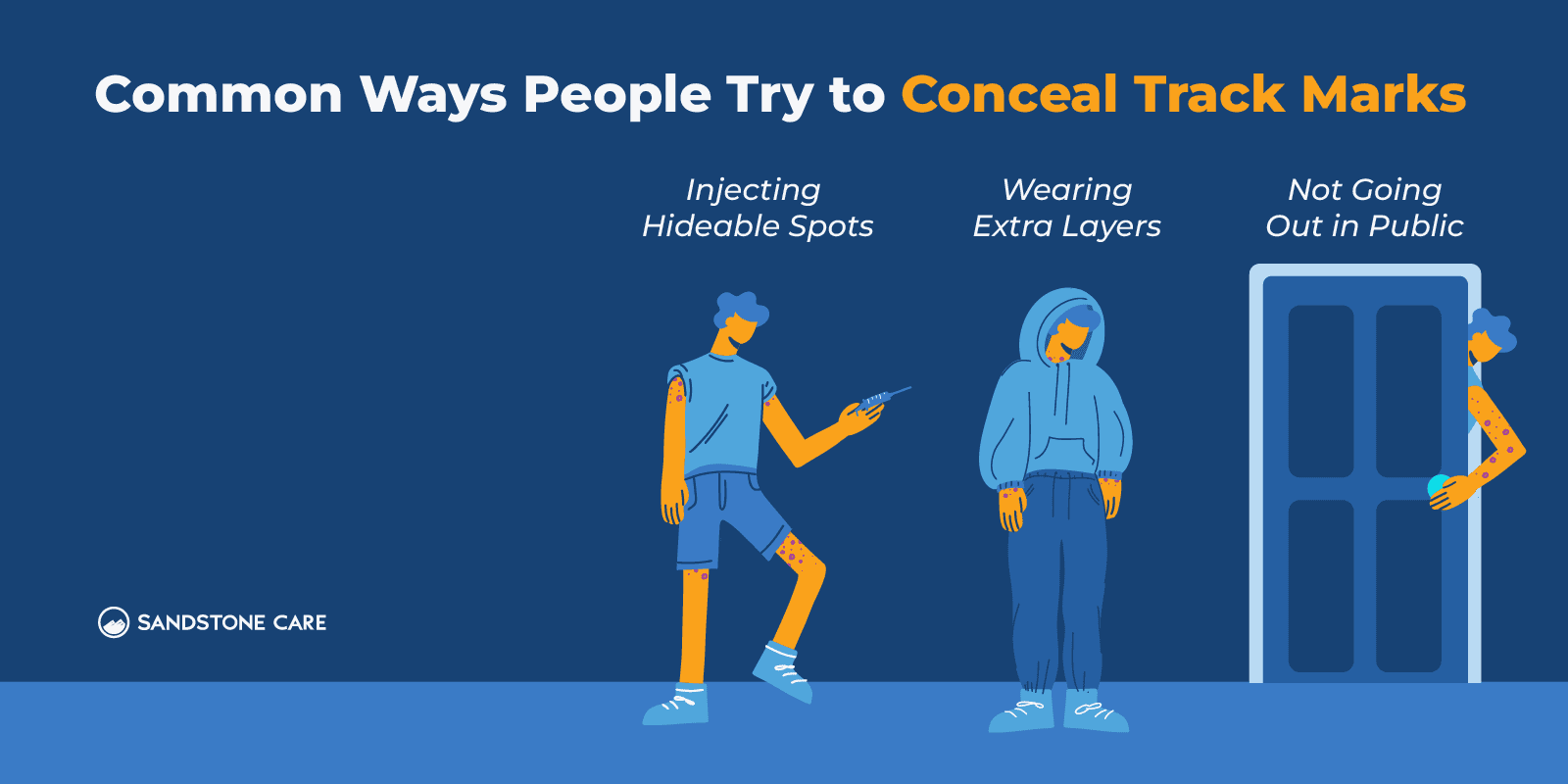
Commonly, those engaging with heroin, methamphetamines, or other IV drugs will wear out-of-season clothes or layers, even in warmer seasons. Noticing a loved one wearing sweatshirts or long sleeves in summer, long pants in hot weather, or even gloves or arm warmers at all seasons of the year may be doing so to cover up track marks.
Others may use makeup to hide physical signs of drug use, matching skin tones to cover up scabs, scarring, or discoloration.
Lastly, many of those overcoming substance abuse may adopt a more secretive lifestyle to hide their use. Locking doors, becoming more socially isolated, and more can all be signs that addiction treatment may be necessary.
How to Get Rid of Track Marks
Track marks are common among IV drug users and can be difficult to get rid of. This is part of why track marks are such a key physical sign of drug use.
Do Track Marks Go Away?
Track marks will heal with time.
However, those continuing to engage with drugs may see them persist for much longer than those who don’t. Addiction can be taxing on the body, making it difficult for these puncture wounds to heal. Along with continued injection of drugs, these marks can have little time to heal before either being reopened.
Getting the right treatment, abstaining from drug use, and focusing on physical and emotional needs are all essential to truly begin the healing process.
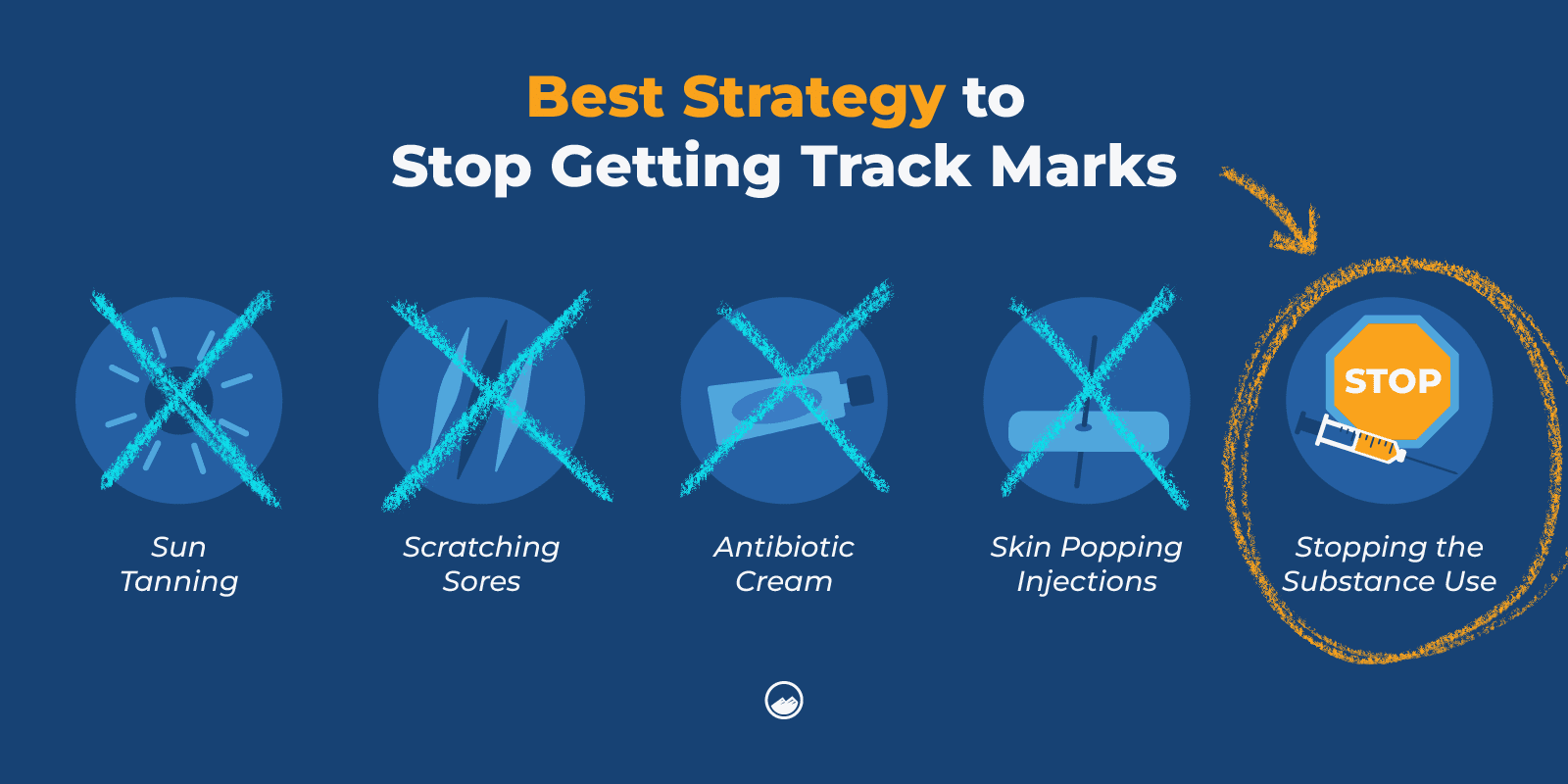
How to Avoid Track Marks
Track marks are intimately tied to the use of IV drugs.
Avoiding IV drug use is the only way to truly prevent track marks from occurring. Engaging in effective detox and treatment programs like those available at Sandstone can help prevent the manifestation of more track marks while embarking on a transformative healing journey.
How to Heal Bruises from Needles
Bruising around the injection site is common and is a major physical sign of drug use.
A warm compress on the affected area can help promote the blood flow needed for the skin to recover. However, this does not necessarily heal the veins entirely, so it is important to avoid injecting more drugs into the skin.
How to Remove Scar Tissue from Injection Sites
Scar tissue is another common sign of IV drug use. While removing scar tissue can be difficult, it is possible to prevent the creation of scar tissue.
Avoiding IV drug use is the only way to truly prevent scar tissue from occurring on a person’s body. However, rotating injection sites, avoiding using old needles, and more can help prevent additional physical health problems.
How to Get Rid of an Abscess from Shooting Up
Abscesses are major indications of the physical damage that injecting drugs can do. Keeping the area clean through washing at injection sites can help prevent abscesses from further damaging a person’s body.
However, as abscesses grow, become swollen, or as the site becomes warm and painful, it is crucial to get professional medical care. It is important to have the abscess drained, and going to the hospital can also help identify and address other physical damages to the body.
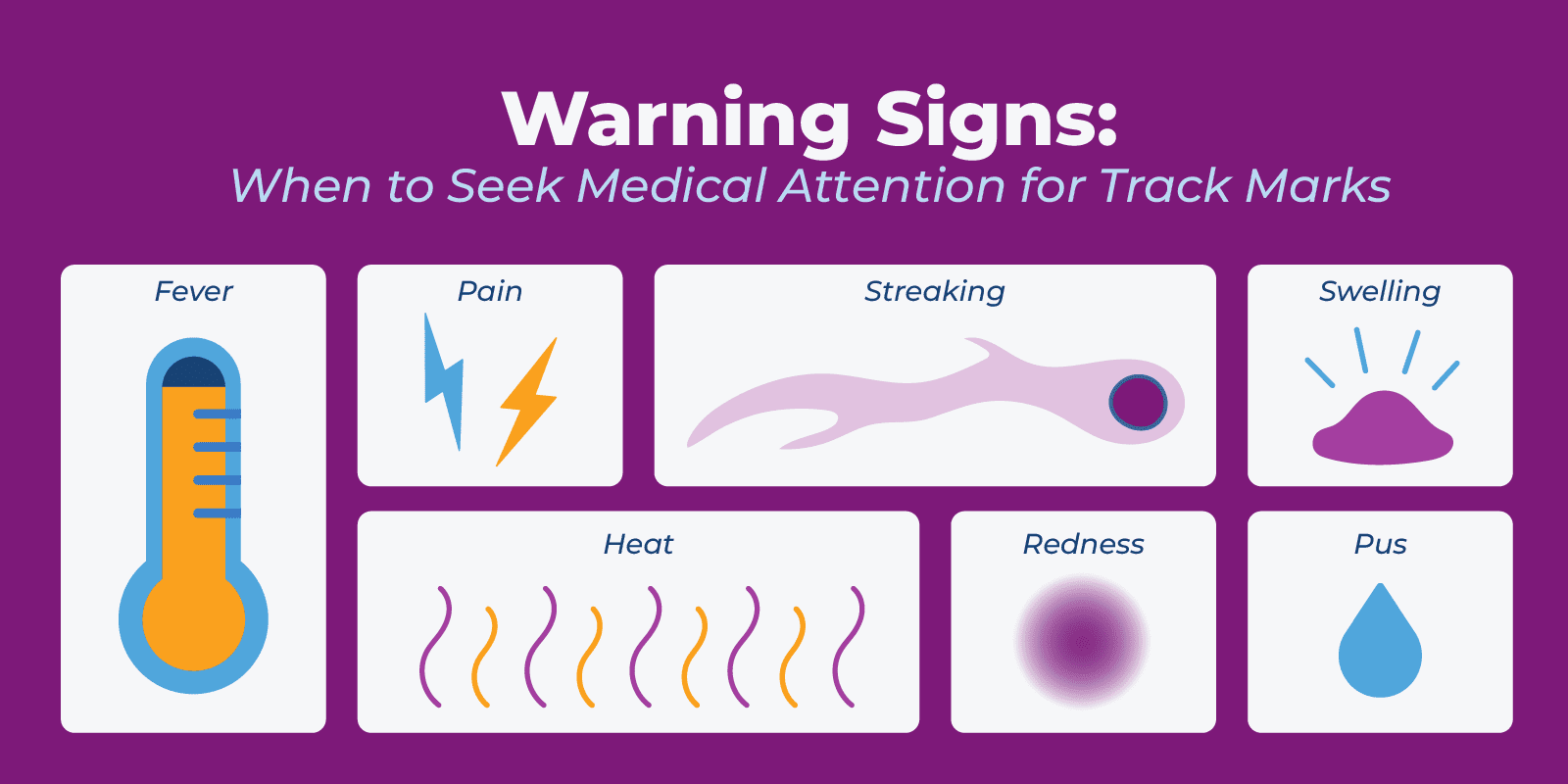
Intravenous Drug Treatment
Track marks are a physical sign of a larger need – to pursue addiction treatment and create a healthy, sober life.
Finding the right treatment and knowing when to commit to change are all part of an effective recovery process.
If I Have Track Marks, Do I Need Addiction Treatment?
Track marks are one sign of IV drug abuse, and there is no “safe” level of engaging with IV drugs like heroin, methamphetamines, fentanyl, and more.
Recognizing track marks on yourself or someone you love is an important sign to explore treatment options. These drugs are highly addictive, and overcoming addiction requires treating both physical and emotional wounds.
How Do You Know If You Need IV Drug Treatment?
Committing to IV drug treatment programs is something to celebrate and marks the beginning of change.
Recognizing the signs of addiction like track marks, mood swings, compromised academic or workplace performance, and other signs of addiction can all indicate the need for IV drug treatment.
There is no “safe” way to engage in IV drug use, and the use of these drugs often comes at a physical, mental, and emotional cost, in addition to how they impact relationships and responsibilities. Professional treatment can address each of these areas while providing the medical and emotional support needed for recovery.
What Are Intravenous Drug Treatments?
Each person will have an opportunity to explore their own unique needs and goals in drug treatment programs, and each can be personalized to best address each unique situation.
You and your loved ones can explore various treatment programs. These may include cognitive-behavioral therapy, dialectical behavior therapy, mindfulness practices, trauma assessment, and nutritional care.
You will also receive medical support during detox and medication management. This will help you find the best approach for recovery from IV drug use.
What Is the Best Type of Treatment for Intravenous Drugs?
There is no single treatment option that is effective for all people equally, and each person will have to address their unique needs, challenges, and goals throughout the recovery process.
However, teaming up with experts to mix proven treatments with unique experiences, life skills, and medications when needed, and taking a family-focused approach to healing for everyone affected by IV drug addiction can create a complete plan for long-term recovery.
Where Can I Go for IV Drug Addiction Treatment?
It’s crucial to start each recovery journey in the right place, and different treatment centers may have different approaches to tackling IV drug addiction.
You can call local facilities to ask about their usual practices, amenities, therapies, and staff qualifications. This can empower those who are looking to start their journey to make this important decision confidently.
Sandstone Care offers this comprehensive approach to IV drug addiction treatment across multiple states, including Virginia, Maryland, Colorado, and Illinois, with multiple locations in each state, making effective treatment more accessible.
FAQ
You Have Questions, We Have Answers.
Our goal is to provide the most helpful information. Please reach out to us if you have any additional questions. We are here to help in any way we can.
Yes. IV drug use damages the veins and can compromise effective blood flow. Blood clots are also common as a result of collapsed veins.
No. The appearance of track marks will disqualify an individual from donating plasma. This is to allow these injection sites to heal, as well as prevent unnecessary contamination, as unsanitary needles used for IV drug use can transmit many diseases, such as hepatitis B and hepatitis C.
There are no home remedies that will immediately get rid of track marks.
This is often why those using IV drugs will instead cover these injection sites by other means, such as long sleeves or other heavy clothing or the use of makeup. The only way to truly get rid of track marks is to abstain from drug use and engage in proper nutrition, often with the help of dedicated treatment programs.
Yes, drug use, especially IV drugs, can commonly cause bruising around the injection site.
The use of needles to puncture veins, coupled with a compromised diet and physical health common as a part of addiction, can cause bruising to be common, necessitating the need for professional treatment programs.


Let’s Take the Next Steps Together
Track marks are a common and distinctive sign of IV drug use. At Sandstone Care, we understand the complicated and tumultuous nature of recovery, and we are prepared to work with you to create the best approach to your sober future. For information on how we can create a program just for you, call us today.

